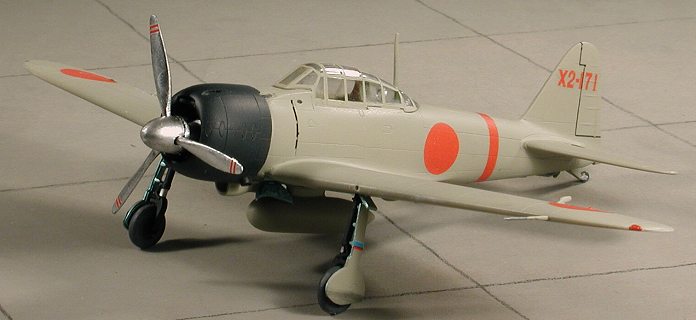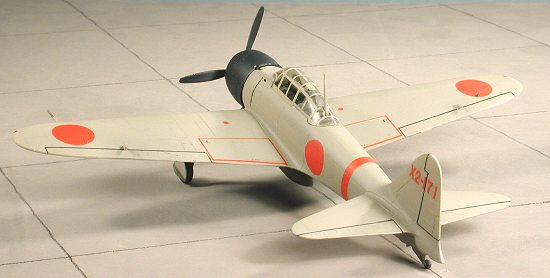
Hasegawa 1/72 A6M3 type 22
|
KIT # |
51315 (AP 15) |
|
PRICE: |
$12.98 |
|
DECALS: |
Three aircraft |
|
REVIEWER: |
|
|
NOTES: |
Currently (Jan 2003) out of production |

|
BACKGROUND |
For a brief history and a look at what is in the box, please visit the preview.

|
CONSTRUCTION |
It will be difficult to do a long review of this kit. The main reason is that it is such a simple kit. There is not much in the way of options or difficult areas, though I did manage to find a few that were not perfect. It isn't a shake and bake kit, but it also is relatively trouble free.
This was a kit that I picked up at a swap meet a few years back. The interior had already been painted though all the parts were still on the sprues and it was otherwise complete. After several unsuccessful attempts at selling this kit on eBay for $4.00, I figured that I'd go ahead and build it. I was also encouraged to do so as I'd mixed up a batch of Ame-iro paint for a 1/48 A6M2 type 21 and wanted to use it before it dried out.
 Though the cockpit was already painted, when I removed the parts
from the sprues, it left areas that had to be repainted. So I went ahead and
repainted all the parts. I used a Humbrol green paint, #86 for this as it looked
pretty close to a Mitsubishi interior green. There are decals for the
instruments so those were applied once the paint had dried. I don't know of much
available in terms of aftermarket detail sets for this kit, though a nice resin
cockpit would definitely help.
Though the cockpit was already painted, when I removed the parts
from the sprues, it left areas that had to be repainted. So I went ahead and
repainted all the parts. I used a Humbrol green paint, #86 for this as it looked
pretty close to a Mitsubishi interior green. There are decals for the
instruments so those were applied once the paint had dried. I don't know of much
available in terms of aftermarket detail sets for this kit, though a nice resin
cockpit would definitely help.
The interior was trapped between the fuselage halves when they were glued together. As with the 1/48 kit, there is an upper forward insert that does not fit perfectly well. No lower insert, thank goodness. The kit comes with a separate lower wing which more accurately represents the type 22 so that was glued to the upper wing. I then opened up the holes for the drop tank and the tank halves were glued together. Attaching the wing was a no brainer, but I found that the fuselage was a teeny bit narrow so there were gaps. Now I know many people who attach the upper wings at the root to prevent this problem and perhaps I should have done that. At the lower aft fuselage/wing join there was a rather large gap that needed several applications to fill and smooth.
 It was at this moment that I noticed a
glitch. You see, the type 22 and later had a separate moveable rudder trim tab.
One is supposed to cut out the section of rudder (it is scribed) and replace it
with a bit in the kit. I forgot. No choice but to sand off the old tab and
scribe in the new one. Doesn't look perfect, but is better than ignoring it. I
know that most of you wouldn't have noticed, but I did and the fix is relatively
easy. The drop tank was glued in place as were the tail planes. Then I spent
some quality time masking the canopy and after installing the DF loop antenna
and radio mast, attached it using Acrabond.
It is super pure superglue and as you can see, didn't fog up the canopy. It is
being marketed by Dave Reed, who can be contacted about it at
dave37167@hotmail.com. I'm really
hooked on it and use it all the time.
It was at this moment that I noticed a
glitch. You see, the type 22 and later had a separate moveable rudder trim tab.
One is supposed to cut out the section of rudder (it is scribed) and replace it
with a bit in the kit. I forgot. No choice but to sand off the old tab and
scribe in the new one. Doesn't look perfect, but is better than ignoring it. I
know that most of you wouldn't have noticed, but I did and the fix is relatively
easy. The drop tank was glued in place as were the tail planes. Then I spent
some quality time masking the canopy and after installing the DF loop antenna
and radio mast, attached it using Acrabond.
It is super pure superglue and as you can see, didn't fog up the canopy. It is
being marketed by Dave Reed, who can be contacted about it at
dave37167@hotmail.com. I'm really
hooked on it and use it all the time.
|
CAMOUFLAGE & MARKINGS |
Hey, it is time to paint!! I chose a scheme from the decal sheet (not a lot of
1/72 aftermarket decals for type 22 Zeros) and so painted the entire airframe
with my mixture of Ame-iro enamel/lacquer. While doing that, I also painted the
engine flat black and dry brushed it rather heavily with aluminum. The engine
cowling got its required coating of Blue-Black using some of my
 remaining
Aeromaster Acrylics. I painted the prop with Alclad II prep and then with highly
polished aluminum. The backs of the blades were later painted flat black.
remaining
Aeromaster Acrylics. I painted the prop with Alclad II prep and then with highly
polished aluminum. The backs of the blades were later painted flat black.
A quick trip back to the bench after all the paint had dried so I could put the kit on its landing gear prior to doing the decals. I don't know if it is correct for the type, but the wheel wells and inside of the gear doors were painted with Polly S Aotake at this time. Landing gear on Zeros are painted black and then the wheels and gear doors were glued in place.
The decals for the 'light grey' version on the decal sheet are for the 202nd Flying Group. From the looks of the markings, they operated out of New Guinea in 1942/43. Having no choice but the kit decals, I was a bit apprehensive in using them, especially as they appeared 'cracked' when held to the light. In fact, they worked fairly well, though a few of them broke apart and some became totally unusable. I applied Solvaset to them as the first ones applied had silvered and though one or two had permanent wrinkles, the rest behaved themselves OK. Once the decals had dried, the plane was given a clear semi-matte coating to seal things in place. I also outlined the control surfaces as I usually do on my models.
|
FINAL CONSTRUCTION |
 With the plane nearly finished only a few other items needed to be added.
This consisted of the tail hook, engine, cowling and propeller. The masking was
removed and a bit of pastel was used for exhaust. Yes, I know this plane was
probably far from pristine, but that is the way that I model and I'm happy with
it that way.
With the plane nearly finished only a few other items needed to be added.
This consisted of the tail hook, engine, cowling and propeller. The masking was
removed and a bit of pastel was used for exhaust. Yes, I know this plane was
probably far from pristine, but that is the way that I model and I'm happy with
it that way.
|
CONCLUSIONS |
This is a great kit and one that should be on the shelf of every 1/72 model builder. It is odd how the information on colors and camo of the last ten years has made nearly every Zero in my collection obsolete! It could be a conspiracy! :o)
|
REFERENCES |
Mitsubishi A6M Zero, by A.Juszczak, Mushroom Models Publications, 2001
Just in case you want to see the difference between the old and new colors of early Zeros, here's a shot of this kit with a similarly painted one done several years ago. As you can see, the difference is not huge, but it is there.

January 2003
#1255 in a series
Copyright ModelingMadness.com. All rights reserved.
If you would like your product reviewed fairly and quickly , please contact the editor or see other details in the Note to Contributors.